Since the Brexit vote last June, I have become an avid viewer of BBC’s Question
Time. Though the electorate voted to
leave the European Union by 52 to 48 per cent, the mood of the audience in
nearly every programme would make you think that margin was more like 70-30.
Perhaps the Brexit supporters are just louder (as victors usually tend to be)
but there is a palpable sense of anger and frustration when the odd person
expresses doubts about the divorce proceedings.
I
am fascinated by the angry Brexit supporters. For a lot of English people, it
seems the EU is like a giant piñata or a star-festooned punchbag. If you’re feeling angry with your lot, you
can take it out on the EU, that unelected heap of bureaucrats who add red tape
to everything and impinge on your rights as the subject of a sovereign nation.
I saw one audience member having a conniption about the straight bananas she
saw in her grocery – bananas that had been straightened by the Brussels
busybodies, of course. In another
edition, a man said that even though he had married a woman from Russia, he
would always regard her as a foreigner. A German woman who said she is already
struggling with the number of forms she has to fill in to extend her stay in Britain
was jeered by some members of the audience. These are the extremists but they
do represent the far end of what appears to be a general sense of antipathy to
all things EU.
It is also
remarkable to see formerly pro-remain MPs now talking up Brexit as a route to a
wonderful global future for Britain and bending over backwards to appease the
extremist wing of the Conservative Party and UKIP. It is exactly the opposite of what David
Cameron intended when he called the referendum. They berate those they call ‘remoaners’ and
repeat the ‘we cannot ignore the will of the people’ mantra to hoots of delight
from the angry ones in the audience.
I
also find the Brexit story engrossing because of the contrast it marks between
Britain and Ireland. There are times when it feels as though the two islands
are almost the same – the language, the clothes, the fevered interest in
English football, the shared taste in television, music, food, the common views
on so many social issues. But when it
comes to the EU, we part company. With the glaring exception of the troika’s
iron fist earlier this decade, the EU has been near-constant ‘good news’ story
for Ireland and for years those ‘partly funded by the EU billboard’ were everywhere,
a pleasing reminder that we were being looked after by kindly neighbours.
Maybe Charles de Gaulle
was right when he twice vetoed the U.K.’s entry into the common market in 1963
and 1967, accusing Britain of a ‘deep-seated hostility’ towards European
construction. He said London showed ‘a
lack of interest’ in the Common Market and would require a ‘radical
transformation’ before joining the EEC. ‘England in effect is insular,’ he said
in 1963, ‘she is maritime, she is linked through her interactions, her markets
and her supply lines to the most diverse and often the most distant countries;
she pursues essentially industrial and commercial activities, and only slight
agricultural ones. She has, in all her doings, very marked and very original
habits and traditions.’
To
my mind, the great difference between Britain and just about all of the
twenty-seven other members of the European Union has to do with their original
motivation for joining the E.U. In 1973, Britain’s economy was in a parlous
state but in contrast to the rest of Europe, the U.K. had had a relatively good
twentieth-century. A winner of two world wars, Britain was one of the few
countries that hadn’t been invaded by an aggressive neighbour. As destructive
as the second world war had been on towns and cities across the country,
British people were generally able to look back with pride on the period from
1939 to 1945. For the British
governments of the 1960s and 1970s, joining the EEC was seen primarily as a
move that would be economically advantageous.
The motivation to establish and then
join the common market on the continent was also partly due to economics. But
there were other, deeper factors at work. The original six members all carried
horrific memories of invasion, brutality and collusion and the sound of
jackboots marching down the streets of villages was still ringing in the ears
of the people of each state. Recent
history was the nightmare from which people wanted to escape. Jean Monnet and
Robert Schumann’s vision of a union of people rather than of states seemed like
an attractive alternative to constant paranoia.
That wish to escape was also fundamental
to post-fascist countries such like Greece, Spain and Portugal’s request to
join in the 1970s and 1980s and post-soviet countries in eastern Europe in the
1990s. While recognising the economic benefits of membership, Ireland also saw
Brussels as a place where they could stand on the same platform as a neighbour
that had dominated them but which was now ostensibly an equal partner. And of course, it would help to dissolve the
border with Northern Ireland.
Of course, Britain didn’t
‘get’ the European project; of course it balked at the notion of 'ever growing union'. With its happy memories of imperial and military
dominance and successful defiance of the swastika, it entered the EEC looking
to improve its trading prospects, while other states entered looking to escape
the past and in some cases, to escape themselves. Still though, it does make
for good telly.








